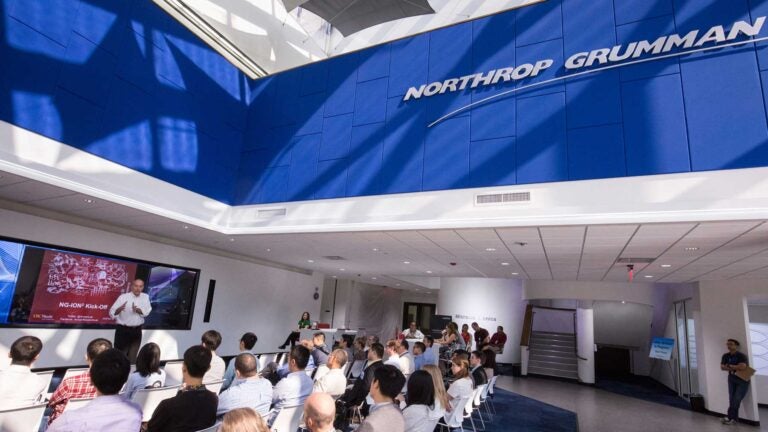
Tom Pieronek of Northrop Grumman speaks at the kickoff event for NG-ION2. (Photo/Courtesy of Northrop Grumman)
It’s back to basics — basic science — for USC, Northrop Grumman
The aim of their new partnership is to create a repeatable model for industry-supported research
What would bring teams from USC and aerospace together to signify the start of a pioneering source in basic scientific research?
That would be the launch of the Northrop Grumman Institute of Optical Nanomaterials and Nanophotonics (NG-ION2) in Redondo Beach.
A uniquely positioned joint institute, NG-ION2 gives USC faculty and students access to select Northrop Grumman facilities and equipment, while allowing top scientists at the company to collaborate directly with USC faculty and students on NG-ION2 projects.
The partnership aims to create a solid, repeatable model for industry-supported research.
Under the agreement, Northrop Grumman will contribute $500,000 to NG-ION2 this year to help foster interdisciplinary research by materials scientists, electrical engineers, physicists and chemists to develop novel materials for optical devices. Andrea Armani, holder of the Fluor Early Career Chair in Engineering, and Jesse Tice, senior scientist and nanomaterials group lead of Northrop Grumman Aerospace Systems, serve as NG-ION2’s co-directors.
“By returning to basic science, Northrop Grumman is strategically investing in and creating an ecosystem that will accelerate future innovations and benefit the entire scientific community,” Armani said.
Complex challenges
Teams at NG-ION2 are already tackling complex challenges that limit the use of advanced materials in integrated photonics. Several of the leading researchers from Northrop Grumman’s Los Angeles team already have visiting scholar appointments in research groups of USC faculty operating at the forefront of photonics and materials science. These visiting researchers facilitate the collaborations between the two campuses, boosting the research efforts and productivity of both institutions.
Tom Piorenek, vice president of basic research for Northrop Grumman Aerospace Systems, was on hand in late August to welcome the seven USC Viterbi professors who make up the inaugural institute and their students. In addition to Armani, they included Yong Chen, associate professor of industrial and systems engineering; Stephen Cronin, associate professor and holder of the Gordon S. Marshall Early Career Chair in Engineering; Michelle Povinelli, associate professor of electrical engineering; Aluzio Prata, associate professor of electrical engineering; Han Wang, assistant professor of electrical engineering-electrophysics; and Wei Wu, associate professor of electrical engineering. Each of these faculty members works directly with a Northrop Grumman counterpart.
No good science is ever wasted.
Herb Abelson
“No good science is ever wasted,” said Herb Abelson, the leukemia researcher after whom the abl gene is named and whose work with viruses in mice helped unravel how a chromosomal mutation leads to chronic myelogenous leukemia.
Still, in our results-oriented culture, the saying “bench-to-bedside” is often used to underscore the need to quickly convert a discovery into a product. Sometimes this overlooks that important discoveries have come as a result of extensive, often unpredictable experiments, initially undertaken with very different purposes in mind, Armani said.
“Basic scientific research is the engine that powers innovation,” Armani said. “The process of creating solutions to tackle grand challenges begins in basic research, and without it, we can’t arrive at meaningful applications.”
